ADDRESSOGRAPH-MULTIGRAPH
GRAPHOTYPE
Please see our
catalog
for Addressograph Machines, Parts and Supplies

DogTagsRus.com is proud
to be a new sponsor of

GRAPHOTYPE.net
is an Internet Forum for the
discussion of Graphotype
machines and dog tags. Please
check out
GRAPHOTYPE.net
Click the banner above.

ADDRESSOGRAPH
History and Information
Sidebar: In
2004, you will still find the words Addressograph
and Graphotype in modern print. Sadly
these words are usually associated with obituaries
in local newspapers. The people that
invented, manufactured, sold, repaired and OPERATED
these machines are being survived by the machines
themselves. We as a nation are loosing whole
generations that are truly the only people who knew
the Addressograph and Graphotype machines
intimately. Some of those lost dedicated their
entire adult career to the Addressograph.
With the
exception of the LinoType machine I cannot think of
any other piece of "office equipment" that has
shaped or had such a profound effect on our
nation and culture as the machines produced by
Addressograph-Multigraph. There have been
books written about Addressograph-Multigraph
employees. Whole companies lived and died by
the Addressograph-Multigraph machines. Nearly
every industry in the United States has at one time
or another been effected by the "mechanical
soldiers" of the Addressograph-Multigraph company.
On
September, 10 2004 Internet searches yielded the
following results:
News papers
between: (1997 - to date)
American Newspapers - Addressograph - 521 hits
American Newspapers - Graphotype - 211 hits
American Newspapers - Addressograph-Multigraph - 493
hits
Dallas
Morning News between: (1885-1977)
Addressograph - 107 hits
Graphotype - 5 hits
Addressograph-Multigraph - 43 hits

ADDRESSOGRAPH-MULTIGRAPH and the GRAPHOTYPE
What a tounge twister - Just what is a
Addressograph-Multigraph and a Graphotype?
Well we have composed a brief history here to to
help you understand exactally what these machines
are and why they are important to the Military Dog
Tags.

History of the
Addressograph-Multigraph Graphotype is as
long and twisted as the name. Just trying to
say Addressograph-Multigraph Graphotype
in one sentence is a tongue twister. We at
DogTagsRus are most concerned with the Graphotype as
it relates to military identification tags, but we
feel to understand the Graphotype you have to also
understand Addressograph-Multigraph the company. While our
history is not all inclusive we hope it is
comprehensive enough to provide a well rounded
account of the Graphotype as it relates to dog tags.
ADDRESSOGRAPH

Addressograph began operations in
1892.
"The first ADDRESSOGRAPH was
made by a young Iowa miller whose genius was
challenged by the daily drudgery of hand addressing
hundreds of grain bids, and who determined to find a
way of doing the work faster and better.
Crude as was his invention, it printed names and
addressed ten times faster than hand-writing.
The first Addressograph was a simple
mechanism for printing from a series of rubber
stamps, arranged in an endless chain. An
address was printed and the next stamp advanced to
printing position each time the plunger was pushed
down by the hand."
Mr. J. S. Duncan was the
inventor of the Addressograph.
AMERICAN MULTIGRAPH
Multigraph started in 1902.
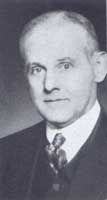
"MULTIGRAPH was conceived by
a typewriter salesman who became convinced that the
field of any business could be broadened - and
profits increased - if facsimile typewritten
letters and other sales messages could be produced
in quantity from type, printed through an inked
ribbon. His first model was immediately
accepted by Business as a practical, profit-making
machine.
The first Multigraph consisted of
two parallel flat plates. Printers' type was
set into the upper one and a letter was produced by
laying carbon paper over a letterhead on the lower
plate and bringing the top plate down sharply
against it."
Mr. H.C. Gammeter was the
inventor of the Multigraph.
ADDRESSOGRAPH-MULTIGRAPH
"The Company"
By 1907, Addressograph was marketing
its "Dupligraph" machine, touted as "the highest
development of the process of producing imitation
typewritten letters." This machine could
print a letter address, body and signature all in
different colors at a rate of 800 to 1200 per hour.
American Multigraph released the "Addressing
Multigraph" in 1927. The Addressing Multigraph
used metal type to address and print form letters
simultaneously. The companies of Addressograph
and Multigraph merged operations in 1931-1932.
On this date was born one of the icon's of the
industrial age a new company called
ADDRESSOGRAPH-MULTIGRAPH Corporation.
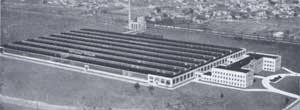
The above is a
photograph of the Addressograph-Multigraph
manufacturing plant as it looked in 1933.
During the 1933 "A Century of Progress"
World's Fair the newly formed A-M Corporation
boosted that the "modern" manufacturing facility
covered more than 8 acres in size and cost over
$2,000,000 to build.
A
CENTURY OF PROGRESS
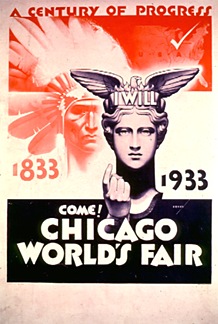
One of the most informative
historical documents on Addressograph-Multigraph
products is the booklet that was distributed by the
A-M company at the 1933 World's Fair held in
Chicago.
The theme of the Fair was "A Century
of Progress" which focused on the time and
changes between
1833 and 1933. The Fair had particular
emphasis on the future and the industrial age.
This Fair documented and illustrated the growth of the
United States as a world leader and industrial power.
Addressograph-Multigraph
produced and distributed a booklet titled
ADDRESSOGRAPH-MULTIGRAPH AT A
"CENTURY OF PROGRESS".
This booklet was distributed as
promotional literature but it remains today as one
of the best reference tools as it visually
demonstrates the broad range of products that
Addressograph-Multigraph offered at the time.
The booklet states that in 1933, the A-M company
offers over 100 different models of business
machines with several thousand different
configurations of each model.
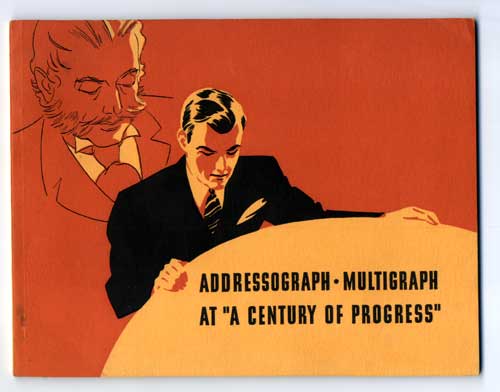
1933 World's Fair promotional
booklet
"ADDRESSOGRAPH-MULTIGRAPH AT "A CENTURY OF PROGRESS"
The Addressograph-Multigraph
Corporation was a company that helped shape and form
America during the industrial age into what we have
become today. The Addressograph-Multigraph
corporation has influenced almost every conceivable
industry from financial, manufacturing and medical
to the religious and the legal professions.
The Addressograph Graphotype machine
is a silent icon - instantly recognizable by those
who are familiar with the machine. Just the
very sight of these machines has an almost magical
and alluring effect on those who encounter them.
The model 6300 Series Graphotypes are a work of
mechanical art. Many a time when we have been
selling dog tags in public have we had people stop
and watch the machines in operation for up to an
hour at a time. Most people are fascinated by
the mechanics of the machine and the thought that
went into the design and fabrication of the
machines.
With the advent of computers and
automated systems, the Addressograph Graphotype has
been phased out and replaced with newer machines
that offer features such as computer interface,
computer control, high production capabilities, etc.
ADDRESSOGRAPH
"The Machine"
Addressographs



The three above
photographs show the original Addressograph machine.
Click on the each photo to enlarge. The belted
addressing plates or rubber stamps can be clearly
seen in the first and second photographs, these
plates are linked together to form a chain of
addresses plates or stamps.
MULTIGRAPH
"The Machine"
The Multigraph is an interesting
machine, but it is different than the
Addressograph as it relied upon loose type to compose
the text imprinted.

On the table to the right the
machine with the round drum and the crank handle is
the Multigraph machine. Essentially this
machine was a form of copy machine. To the
right you can see the sloped front cabinet, this was
the typesetter used for the Multigraph machine.
Type would be put into rows on the
Multigraph and the drum of the Multigraph would be
turned much like a duplicating machine. With
the each rotation of the drum the Multigraph would
leave an impression thus printing text on to a blank
page. This machine was used to mass produce
letters that had the appearance of personalized
individually typed letters. The Multigraph was
essentially the predecessor of the modern
duplicating machine much like the ones found still
in use today, except that the text appeared to have
been typed on a type writer.

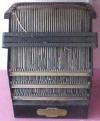
The two above photographs are clear
illustrations of both the Multigraph and it's
companion type setting rack. They Multigraph
is on the left and the type setting rack is on the
right. Notice that the loose type was stored
in the rack and would fall down into place to be
used when composing the text to be printed.
GRAPHOTYPE
"The Machine"
" Dog Tag" Machine
NOTE: We have compiled so much
information on the individual Graphotype models that
have have now dedicated individual pages to each
model. For detailed information on each model
please click on the representative button for that
model to be taken directly to the specific page.
You may select from the menu below or use the button
listed within each model summary found on this page.
The Graphotype is the one machine
that is integral and essential to many of the Addressograph
products. The graphotype is the machine that
either embosses or debosses the metal plates that
are used by the Addressographs themselves.
With as many variants of the Addressograph that
there are the Graphotype also has numerous variants,
models and configurations. Many times the
Graphotype was built or configured to suite for a
particular application.

This
photograph shows a typical installation of
Graphotypes as they were employed in large
corporations and business. The Graphotype was
essential to company operations as it was the
backbone that produced the metal plates for the
Addressograph machines. This photograph
illustrates at lease 13 Graphotypes that can be
seen. If one looks closely it is assumed that
there are many more that did not make it in the
photo. It is sad as many people who are
passing today have listed in their obituaries the
fact that at one time or another they were an
Addressograph operator. The machines produced
by Addressograph Multigraph effected whole
generations and yet many people today have no idea
how large a role these machine played in history.
Many people spent their entire adult career as an
Addressograph operator.
While the Graphotype may be found in
thousands of models and configurations the principal
behind all Graphotypes remains the same. The
machine uses a set of dies and punches to either emboss or
deboss metal plates or tags for a given application.
Graphotypes come in two styles - either hand
operated (manual) or electric (motor-driven).
The motor driven machines are faster and more geared
toward production.

This
photograph shows a woman operating a 6300 series
Graphotype machine. In this photo you can
clearly see the plate tray which is on the right
hand side of the machine and slants up from the
storage drawer that is fixed to the legs. Also
visible is the clipboard that is mounted on the left
hand side of the upper part of the machine.
Notice how the base and legs are rounded and curved.
These machines were made of cast iron and they were
build to last. Something about these machines
just says this machine was made to work.
The Addressograph Graphotype is an
interesting animal. Many people will look at
one of the machines and their first comment is, "I
know what that is, it is a . . ."
A Linotype Machine
A Dog Tag Machine
A old electric typewriter
A computer punch card machine
A knife sharpener
One person out of a hundred actually
knows that the machine is a Graphotype. Maybe
three people of out a hundred will tell me the
machine is an Addressograph.
The purpose of the Graphotype was to
imprint information on to metal plates.

To the left is a photograph of the
three most common size plates used in the
Addressograph machines. The Graphotype was
used to imprint the information that was on the
paper label on the metal plate. The metal
plate was used in the Addressograph to transfer the
imprinted information onto mailing lists, invoices,
etc.

Manual Graphotype
By definition we consider the
"manual" Graphotype machines to be machines that do
not have motors or require electricity to operate.
The machines that fit into this classification are
considered hand operated machines, where by which
the operator must manually actuate some feature such
as a hand lever, etc., to cause the machine to
imprint the plate for each character.
The manual Graphotype machines come
in many configurations. On some machines the
operator must select the character to be stamped via
a selection wheel and indicating dial, while on
others the operator will select the character from a
bar, moving the indicator to the right and left to
the desired character. While the selection of
the individual character may be different the
operation of the various machines is much the same.
The operator selects the character to be stamped,
then pulls a lever by hand which loads the spring
and stamps the metal plate once each time the lever
is pulled.
There are several versions of the G1
- 6100 series and 350 series manual machines.
We have dedicated pages for several versions of
these machines please check these pages for detailed
information and photographs.


Electric Graphotype
The electric Graphotype comes in two
different configurations - the manual-electric
Graphotype and the keyboard electric Graphotype.
The main characteristic that is consistent between
the two machines is the fact that the machine
requires electricity to operate. Most all of
the electric machines are driven by a 1/4 hp
electric motor. The difference between the
manual electric and keyboard electric machines was
the method of user interface to cause the machine to
imprint the text.
6200 Series Manual-Electric:
Is a manual user selected version where by which the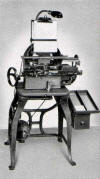
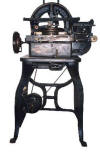 operator manually selects the individual character
to be imprinted by either turning a wheel or sliding
a selection lever across a bar to pick the
individual character.
operator manually selects the individual character
to be imprinted by either turning a wheel or sliding
a selection lever across a bar to pick the
individual character.
Graphotype 6200 series machines
encompass most of these "Manual-Electric,"
offerings.
There are many models within the
6200 series family at the time of this writing we
have been unable to locate detailed and specific
information as to the variations between individual
modes within the series. As more information
becomes available we will update the data.

6300 Series Keyboard-Electric:
These machines are keyboard operated electric
machines, where the operator types the characters on
a keyboard much like typing on a typewriter or
computer.
The Graphotype 6300 series machines
are keyboard operated electric machines. These
6300 series machines are the single most
recognizable Graphotype style machine that many
envision when they think of a Graphotype.
Within the 6300 series of Keyboard
Electric machines there were literally dozens of
model numbers with thousands of variations of each
model number. Some of the 6300 series machines
embossed while others debossed, some printed
backwards, most printed right to left while others
printed left to right.
One mistake that most people make
when they are looking at 6300 series machines is
that they do not realize the thousands of variants
of each machine that were produced and they assume
that one model number is the same as another machine
of the same model number. With Addressograph
Graphotypes the model number will get you close to
what each machine is in terms of characteristics but
in reality each machine is individual. Many
times Addressograph would not put the machine
together until the order was placed.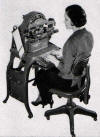
The main features of the 6300 series
machines such as the base, castings, housings,
guards, etc., were all interchangeable and were
pre-made ready and assembled. The one thing
that makes each Graphotype unique is the fact that
each Graphotype was configured for a specific
application before it shipped from the factory.
These machines were used for many more applications
other than just making military identification tags
an as such each machine was tailored to the end
users specific application. Some users may
have been making data plates for electric motors and
the plate may have been 6" x 4" in size - this would
have dictated meant that the jaws, carriage travel,
spacing, etc., would have all had to be modified for
the end user.

NOTE: Because of the shear number of
variations of each model within the 6300 series this
makes searching for a machine ready to make military
dog tags a gamble unless you know exactly what you
are buying. At DogTagsRus, we receive several
e-mails a week from people who have spent their hard
earned money on a 6300 series machine because
someone said it would make dog tags - only to find
out that - yes it will, but it will take extensive
modifications, parts and lots of money to get to the
point that it will print dog tags. Parts for
these machines are extremely expensive. We see
machines on Ebay sell for thousands of dollars that
will never make a dog tag unless they are completely
rebuilt. DogTagsRus encourages ANYONE
interested in buying a Graphotype to make dog tags
to become educated before you purchase. Save
your money until a machine that is right becomes
available. DogTagsRus, has purchased 7+ 6300
series machines, only one of the machines was able
to print dog tags without modification or parts.
You can check back with DogTagsRus as we will be
building an extensive and detailed 6300 series page
dedicated only to the 6300 series machine, its parts
and operation. Look for this page to come
on-line somewhere around December 2004.
Some of the more common variants of
the 6300 series machines are:
|
Model
Number |
Photograph |
| 6340 |
Photo |
| 6341 |
Photo |
| 6350 |
Photo |
| 6351 |
Photo |
| 6381 -
Characterized by offering both upper and
lower case type. |
Photo |
6400 Series
Cabinet-Keyboard-Electric: This style of
Graphotype is the last in the series of
"non-computerized," or Addressograph-Multigraph
style Graphotype machines. This
cabinet-keyboard-electric machine is represented by
the 6400 series Addressograph Graphotype.
The 6400 series Graphotype is by far
the largest of the Graphotype series of machines.
It is essentially an improved version of the
Graphotype 6300 series machines with slight
variations in capabilities and operating
characteristics. The physical size of the
actual machine components changed very little from
the 6300 to the 6400, but the overall footprint of
the machine changed significantly.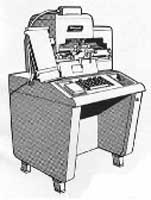
The 6400 series machine was the
beginning of the streamlined, politically correct
and "modern" Graphotype. The 6400 series
machines were the predecessors of the modern
computerized Graphotype replacements. The
single most distinguishing characteristic of the
6400 series Graphotypes that makes them stand out is
the sheet metal cabinet that has been added to the
unit. The complete Graphotype machinery and
mechanisms have been shrouded by a cabinet
fabricated from sheet metal.
The 6400 series machine is the first
Graphotype offering that essentially has NO
character. It give the appearance of a large
"block", that occupies about 48"l x 48"w x 48"h, so
what you really have is a beige cube that just sits
there. The only thing that differentiates the
6400 series of machines from a motel ice machine is
the fact that there is a keyboard stuck on the front
and a work light.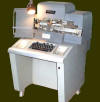
Aside from having absolutely no
character, the 6400 series of machines did
incorporate many new and technical advancements over
their 6300 series cousins. The 6400 series
machines had some significant enhancements and
capabilities that were not available on the 6300
series machines.
|
Feature |
6300 |
6400 |
| Emboss/Deboss |
Yes |
Yes |
| Imprint
on Metal |
Yes |
Yes |
| Imprint
on Plastic |
NO |
Yes |
| Automatic
back space |
NO |
Yes |
| Adjustable
impact settings/pressure |
NO |
Yes |
| Protective
Guards |
Yes |
Yes |
| Sheet
Metal Cabinet |
No |
Yes |
| Work
Light |
Yes/No |
Yes |
| Upper/Lower
case |
Yes/No |
Yes |
The 6400 series
machines has the ability to adjust on the fly - the
stamping pressure so that it can print either metal
plates or plastic cards. The 6400 series
machines are more complicated than the 6300 series
machines in terms of that they have many more
adjustments, make the use of cables and pulleys and
are comprised of more components overall.
Of the people that own and use
Graphotype machines we have found that you either
love the 6400 or you hate the 6400 - there is no
middle ground. These machines usually sell for
less than the 6300 series machines as they are
larger, most people don't know what they are and
they do not have the "appearance" of a classic dog
tag machine.
In terms of functionality the 6400
series machines are just as serviceable for dog tags
as any 6300 series machine. The only draw
backs are that if the 6400 series machines become
out of tune they are harder to maintain and they are
larger and heavier thus making them for all
practical purposes "non-portable" machines.

ADDRESSOGRAPH GRAPHOTYPE
and
The United States Military
The original specification for
military identification tags called for a machine
that would imprint 18 characters per line with 5
lines per tag. While the majority of
Addressograph Graphotypes will not print 18
characters per line they will print 15/16 characters
per line.
Not wanting to developed specialized
equipment or "re-invent" the wheel the United States
Military sought to use a ready made machine
available in the commercial main stream that they
could use to imprint identification tags.
While several methods and options were explored
Addressograph had the Graphotype that with minimal
modifications could immediately be pressed into
service without the need to manufacture a
totally new and dedicated machine. The only
qualification that the Addressograph Graphotype
could not meet was that of the 18 character per line
spacing. The military made the decision that
the 15/16 character per line spacing would be
sufficient for a majority of the military
applications and issued an approval for a deviation
request allowing for the 15/16 character spacing.
Upon approval of the deviation
request was obtained the Addressograph Graphotype
became the primary imprinting machine for military
identification tags and has still remains in
military inventory to this day. Since the time
of WWII the Addressograph Graphotype machine
has been the primary machine used to
imprint military identification tags or dog tags.
Not until the mid-1980's did the Government
begin to replace the Addressograph Graphotype
machines with newer more modern "computerized" machines.
Though the Addressograph Graphotype
machine is no longer manufactured these machines can
still be found within elements United States military
worldwide. Only when an Graphotype needs
replacement for mechanical reasons does the military
"retire" or dispose of these machines.
When an Addressograph Graphotype is
slated for retirement it finds its way to the
Defense Reutilization Marketing Service (DRMS/DRMO)
facility and is either auctioned off as "military
surplus" or sold for scrap metal.
The current line of computerized
embossing/debossing machines are smaller, faster and
have the ability to run high production runs of
identification tags with minimal operator
interaction. Many of these new computerized
machines are offered by manufacturers such as CMI,
etc., etc.
The Addressograph Graphotype machine
has been entrenched in the Government machine for
years. The history of the Addressograph with
the military is confusing as well as overwhelming.
The list below indicates a hand full of
Addressograph Machines and their corresponding
Government assigned National Stock Number (NSN).
This list is by no means all inclusive but is fairly
representative of how intertwined the Addressograph
and the Government have become.
NSN
National Stock Number |
Addressograph
Model Number |
Government Name |
|
7490-00-688-9866 |
M350-1 |
Embossing Machine |
|
7490-00-663-3843 |
6341 |
Embossing Machine |
|
7490-00-655-5750 |
6440 |
Embossing Machine |
|
7490-00-655-5749 |
6481 |
Embossing Machine |
|
7490-00-655-5748 |
6441 |
Embossing Machine |
|
7490-00-634-6678 |
6341 |
Embossing Machine |
|
7490-00-634-2040 |
6481 |
Embossing Machine |
|
7490-00-612-5363 |
355 |
Embossing Machine |
|
7490-00-612-5362 |
350 |
Embossing Machine |
|
7490-00-594-3557 |
6340 |
Embossing Machine |
|
7490-00-559-8454 |
6743 |
Embossing Machine |
|
7490-00-559-8453 |
6783 |
Embossing Machine |
|
7490-00-559-8451 |
6753 |
Embossing Machine |
|
7490-00-559-8449 |
6741 |
Embossing Machine |
|
7490-00-559-8377 |
6341 |
Embossing Machine |
|
7490-00-559-8376 |
6346 |
Embossing Machine |
|
7490-00-559-8375 |
6340 |
Embossing Machine |
|
7490-00-559-8374 |
6381 |
Embossing Machine |
|
7490-00-559-8373 |
6281 |
Embossing Machine |
|
7490-01-007-9204 |
350-1 |
Embossing Machine |
|
7490-00-481-9277 |
6870 |
Embossing Machine |
|
7490-00-030-2614 |
6781 |
Embossing Machine |
|
7490-00-060-5293 |
6821 |
Embossing Machine |
|
7490-00-269-1023 |
6381 |
Embossing Machine |
|
7490-00-269-1022 |
6341 |
Embossing Machine |
|
7490-00-153-9687 |
6341 |
Embossing Machine |
|
7490-00-881-2213 |
6381 |
Embossing Machine |
|
7490-00-881-2212 |
6341 |
Embossing Machine |
|
7490-00-881-2211 |
6341 |
Embossing Machine |
|
7490-00-813-0148 |
M3 |
Embossing Machine |
|
unknown |
70 |
Imprinter, Medical |
|
Model 70 |
Model 70 |
Medical
Imprinter |
How many
various Graphotypes were used by the military?
This is a good question with a not
so clear answer. The
above table ONLY indicates graphotypes that were
assigned NSN's after 30 September 1974.
Notice how many times just the
Graphotype Model 6341 has been issued a different
National Stock Number (NSN). Six (6) times
since the military has been issuing NSN's the 6341
has been given a new stock number. The
military did not start using NSN's until 30
September 1974. Prior to the issuance of NSN's
items were assigned a FSN or Federal Stock Number.
This brings up the question of how many more
identifiers or numbers were assigned to just the
6341 before NSN's?
How many Federal Stock Numbers were
assigned to Graphotypes? The first use of
Federal Stock Numbers was in 1949. FSN's did
not become managed and standardized until 1952.
Prior to Federal Stock Numbers
military services (i.e. Army & Navy) operated
independently and maintained their own separate
supply systems with their own respective procedures
for cataloging items and material. As a
result, many items were given a different name and
number by each of the services, making efficient use
of available stock impossible. Evaluation of
logistical problems after WWII clearly demonstrated
these inefficiencies and led to the creation of the
Federal Stock Number and an agency to administer the
FSN. At this time we have been unable to locate a
list of FSN's that were assigned to Graphotype
machines.
Army Stock Number 54-M-29065 - hand
operated embossing machine
Army Stock Number 54-M-29055-50 - hand operated
embossing machine
Army Stock Number 54-M-29055 - motor operated
embossing machine
Medical Department Number - Model 70 - 99387
NOTE: In 2002 the military used a
Graphotype to prepare identification tags for
deployment.
/A 1940's era World
War II identification tag maker, the Graphotype,
looks like an old fashioned typewriter. Pfc. Michael
T. Burdick, uses it to make "dog" tags at one of the
readiness stations. " I made 146 identification tags
this weekend - it takes me about one minute," he
stated. Medical alert tags are also made here./ -
excerpt from Guard Times, 2002
CURRENT ISSUE
EMBOSSING/DEBOSSING
EQUIPMENT USED BY THE UNITED STATES MILITARY
The military purchases replacement
imprinting equipment based upon bid and Government
Services Administration (GSA) contracts. What
this means is that there is a host of companies that
are currently providing imprinting machines to
replace the Graphotype machines.
While it is fully understandable
that equipment over time becomes dated and may need
replacement for a variety of reasons, NO imprinting
machine or current replacement will ever have the
long lasting impact that the Graphotype has had on
the United States Government or the military.
Here are some examples of current
replacement imprinters.



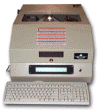

Click on anyone of
these photos to see an enlargement of the imprinter.
The current crop of replacement
"computerized" imprinting machines have NO
character. They are fabricated from plastic
and resemble table top laser printers. While
there is no argument that these machines are
technically superior to the Graphotype, these
machines have become just another piece of
"computer" equipment. The newer imprinters
have no personality.
Current imprinting machines
generally have more features such as:
-
Hopper Feeding - so that 100's
of dog tags can be made per hour.
-
Computer Interface - so that dog
tags can be made from spread sheets and data bases
full of information.
-
High Speed Printing capabilities - that
allow the machines to crank out 100o's of dog tags per
day. Some of these machines boost that they can
complete one tag every 18 seconds complete with five
lines of information.
-
LCD Displays - for manual entry
verification of data being imprinted or visual
diagnostics.
Current issue replacement imprinters are
offered by a variety of companies.
CIM - Card Imaging Master
Addressograph/Newbold - American Owned
Norcom
Automark
DataCard
While the newer modern imprinters are
smaller, faster and computerized - they do carry a hefty
price tag. Current GSA pricing lists indicate the
following:
Interesting note:
the current GSA catalog indicates that the machine
recommended for dog tags or military identification tags is
a debossing machine. The notched dog tags of
WWII, Korea and Vietnam were also debossed. The
Addressograph Model 70 medical imprinter is designed to work
with debossed tags. Embossed tags will not print
correctly in the medical imprinter.

CIM M10
M10 - Manual Metal Plate Embosser - base price: $3400.00 -
debossing
M10 - Manual Metal Plate Embosser - base price: $3650.00 -
embossing
Hand Operated
Embossing dies or Debossing dies
Intended for low volume operations

CIM ME1000
ME 1000 - Manual Feed Metal Plate Embosser
Base price: $10,300.00
RS232 communications port
Can be operated on-line with a PC/Mainframe or off-line with
the included keyboard.
 CIM
ME2000
CIM
ME2000
ME 2000 - Automatic Feed Metal Plate Embosser
Base price: $14,300.00
RS232 communications port
Can be operated on-line with a PC/Mainframe or off-line with
the included keyboard.
 CIM
Metal 3000
CIM
Metal 3000
Metal 3000 - Side Eject Automatic
Base price: $25,371.00
RS232 communications port
Can be operated on-line with a PC/Mainframe or off-line with
the included keyboard.
Suited to high volume operations
By in large the most predominate dog tag
embosser replacement for the Graphotype are the machines
made by the CIM company. CIM prices are fairly
representative of all current replacement machines therefore
we have used CIM's published GSA pricing to compile the
pricing data here.
ADDRESSOGRAPH Related
DEFINITIONS:
Emboss - Embossing is to press an
image into paper, metal or plastic so it lies above
the surface. Also called cameo and tool. The creation of a raised (embossed) image by
pressing a shape into a sheet of paper with a metal
or plastic die. Also see our page dedicated to
Embossing/Debossing.
Deboss - a machine presses a
die into the surface of the material, resulting in a
depressed imprint. To press an image into
material so it lies below the surface. Also
called "tool". Also see our page dedicated to
Embossing/Debossing.
Addressograph
Multigraph
Graphotype
Addressograph-Multigraph
A-M
NSN (National Stock Number) -
A national stock number (NSN) is a 13-digit number
assigned by the Defense Logistics Services Center
(DLCS) to identify an item of material in the supply
distribution system of the United States. It
consists of a four-digit federal supply
classification (FSC) and a nine-digit national item
identification number (NIIN). The NIIN
consists of a two-digit national codification bureau
(NCB) code and seven digits which, when used
together, uniquely identify each NSN item in the
Federal Supply Dirstribution System (FSDS).
FSN - Stands for Federal Stock Number - this was
replaced by the NSN.
BIBLIOGRAPHY
1.
ADDRESSOGRAPH-MULTIGRAPH at "A CENTURY OF PROGRESS"
Published 1933 - Addressograph-Multigraph
Corporation
Cincinnati Ohio, 90 Pages.
2. GlobalSecurity.org
- Battle Creek Federal Center
http://www.globalsecurity.org/military/facility/battle-creek.htm
Last Modified: November 19, 2002
DogTagsRus.com is proud
to be a new sponsor of

GRAPHOTYPE.net
is an Internet Forum for the
discussion of Graphotype
machines and dog tags. Please
check out
GRAPHOTYPE.net
Click the banner above.
eBay NOTICE:
All photographs
on this site have been watermarked. All Text or content on
this web site is copyright protected. If any photographs,
content or text are
used on eBay you must provide proper credit toward DogTagsRus.com
If you elect to NOT provide proper credit
or forget to provide proper credit for anything found on this web
site DogTagsRus.com
will contact eBay and have your auction canceled.
DogTagsRus.com is
more than happy to allow the use of it's photographs and content
provided that proper credit is given - for information on the use of
photographs or content please contact us direct.
Any questions contact us direct
